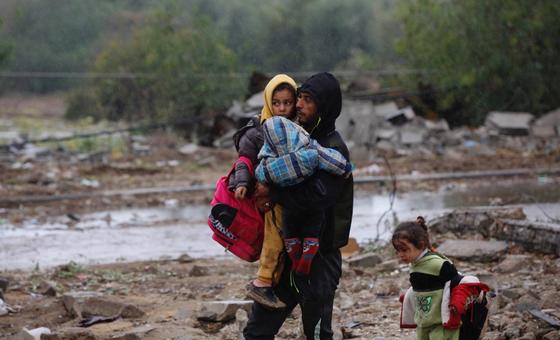The sound of shells exploding shortly after 7am Gaza time was clearly audible at Nasser hospital in the south, where terrified and traumatised youngsters immediately reacted by clinging to their mothers in fright, said James Elder from the UN Children’s Fund (UNICEF).
“The bombs started just a few seconds after the ceasefire (ended),” Mr. Elder told journalists at UN Geneva via video link from Khan Younis, before decrying the “ongoing war on children”.
Wounds of war
“As we approached Nasser hospital there had been a hit, a missile, a rocket, something…Children with the wounds of war are everywhere, children with the wounds of war are still in corridors. Hundreds of women and children take refuge in here. You walk out of ICU (intensive care unit) and there are families of five on a mattress for two.”
The return to violence follows the end of a week-long pause in hostilities between Hamas militants and Israeli forces that allowed the delivery of desperately needed fuel, food and water, which people have been drinking as soon as it is given to them, humanitarians report.
The pause also enabled the release of hostages taken during Hamas’s 7 October surprise attack on southern Israel and ensuing massacre of some 1,200 people, and the freeing of Palestinian prisoners held in Israel.
Gaza’s health authorities have reported more than 15,000 fatalities since the Israeli strikes began, with thousands of children believed buried under the rubble. The conflict has also created around 1,000 child amputees in recent weeks, Mr. Elder noted.
UN chief leads new ceasefire appeal
Writing on X, formerly Twitter, UN Chief Guterres led calls for the warring sides to return to the negotiating table to agree on a long-lasting ceasefire to allow desperately needed aid into Gaza.
“I deeply regret that military operations have started again in Gaza,” he said. “I still hope that it will be possible to renew the pause that was established. The return to hostilities only shows how important it is to have a true humanitarian ceasefire.”
Let aid in, urges rights chief
Echoing that call for peace, UN High Commissioner for Human Rights, Volker Türk, expressed deep concern at declarations by Israeli political and military leaders “planning to expand and intensify the military offensive”.
“The resumption of hostilities in Gaza is catastrophic,” the UN rights chief said, before urging all parties and States with influence over the warring sides “to redouble efforts, immediately, to ensure a ceasefire – on humanitarian and human rights grounds”.
The “full respect and protection of the human rights of Palestinians and Israelis” remain critically important, Mr. Türk stressed, before calling for an immediate end to the violence and the prompt and unconditional release of all remaining hostages.
He said civilians must be protected in line with international humanitarian law, appealing to Israel “as the occupying power…to ensure that the basic needs of the population in Gaza, such as food, water, and medical care, are met. I remind all parties of their obligation to allow and facilitate rapid and unimpeded passage of humanitarian relief for civilians in need, throughout Gaza.”

A Red Crescent worker at the Al Quds hospital in Gaza flees bombing. (file)
Hospital ‘like a horror movie’
Medical needs continue to far outstrip available care, the UN health agency has warned, with some 5,000 beds required but only around 1,500 to hand and only 51 out of 72 primary healthcare facilities now functional, said Dr Richard Peeperkorn, World Health Organization (WHO) Representative on the Occupied Palestinian Territory, speaking from Gaza.
“The Gaza health system has been crippled by the ongoing hostilities and I want to stress that we cannot afford to lose any more hospitals or hospital beds,” he said.
He also highlighted a study in the medical journal The Lancet that confirmed mortality statistics reported by the enclave’s health authorities indicating more than 6,200 children have died, over 4,000 women and roughly 4,850 men, with over 36,000 injured.
Floors ‘awash with blood’
At one small hospital in Gaza City that is the only functioning trauma centre for the north of the enclave, staff are overwhelmed and “bodies are lined up in the car park outside (and) the floor is just awash with blood,” said WHO Rob Holden, WHO Senior Emergency Officer.
“The only way to describe it, it’s like a horror movie. When you walk in there there are patients on the floor with the most traumatic injuries that you can imagine, potentially battlefield trauma. You know, the patients are given the best possible care, but the number of staff available is relatively small, any of this stuff, have fled with their families or have been killed.”
“The supplies are just not enough. There have been major problems of getting supplies to the north of Gaza as well…as you drive into the hospital, you are met with bodies deceased who’ve died either on arrival at the hospital or during their stay at the hospital, lined up outside, waiting for family members to come and identify them.”
Speaking from Gaza, the WHO official explained that doctors, nurses, lab technicians and engineers “who keep the machinery running, the generators are running” were working 22-hour days “just to give the most basic level of service”.

